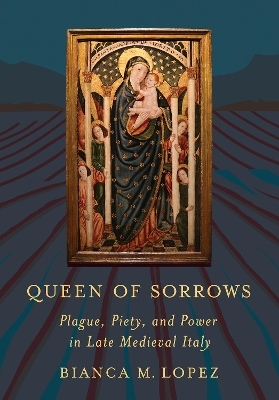
Queen of Sorrows
Plague, Piety, and Power in Late Medieval Italy
Seiten
2024
Cornell University Press (Verlag)
978-1-5017-7591-8 (ISBN)
Cornell University Press (Verlag)
978-1-5017-7591-8 (ISBN)
Queen of Sorrows takes an original approach to both late-medieval Italian history and the history of Christianity, using quantitative and qualitative analyses of a remarkable archive of 1,904 testaments to determine patterns in giving to the Virgin of Loreto shrine in the late fourteenth and early fifteenth centuries. Bianca M. Lopez argues that in central Italy, as elsewhere, the cult of the Virgin Mary gained new prominence at this time of unprecedented mortality. Individuals gave to Santa Maria di Loreto, which houses the structure in which Mary is believed to have lived, as an expression of their grief in the hope of strengthening family lineages beyond death and to care for loved ones believed to be languishing in purgatory.
Lopez establishes statistical correlations between different social groups and their donations to Loreto over time, uncovering informative new historical patterns such as the prominence of widow and migrant donors in the notarial record. The testaments also provide a social history of Recanati, revealing how its denizens venerated Mary as a saint with unrivaled spiritual power and uniquely sympathetic to grief, having lost her own son, Jesus. In the fourteenth century, plague survivors transformed their anguish into Marian devotion. The devastation of the plague brought the Virgin out of noble courts and monasteries and onto city streets. As Queen of Sorrows details, however, the popularity and growing wealth of Loreto's Marian shrine attracted the attention of the papacy and peninsular seigneurial lords, who eventually brought Santa Maria di Loreto under the control of the Church.
Lopez establishes statistical correlations between different social groups and their donations to Loreto over time, uncovering informative new historical patterns such as the prominence of widow and migrant donors in the notarial record. The testaments also provide a social history of Recanati, revealing how its denizens venerated Mary as a saint with unrivaled spiritual power and uniquely sympathetic to grief, having lost her own son, Jesus. In the fourteenth century, plague survivors transformed their anguish into Marian devotion. The devastation of the plague brought the Virgin out of noble courts and monasteries and onto city streets. As Queen of Sorrows details, however, the popularity and growing wealth of Loreto's Marian shrine attracted the attention of the papacy and peninsular seigneurial lords, who eventually brought Santa Maria di Loreto under the control of the Church.
Bianca M. Lopez is W. R. Nicholson Endowed Assistant Professor of Medieval and Renaissance Studies Southern Methodist University.
| Erscheinungsdatum | 03.08.2024 |
|---|---|
| Reihe/Serie | Medieval Societies, Religions, and Cultures |
| Zusatzinfo | 2 Maps; 5 Graphs; 6 Halftones, black and white |
| Verlagsort | Ithaca |
| Sprache | englisch |
| Maße | 152 x 229 mm |
| Gewicht | 907 g |
| Themenwelt | Geschichte ► Allgemeine Geschichte ► Mittelalter |
| Geisteswissenschaften ► Geschichte ► Regional- / Ländergeschichte | |
| Geschichte ► Teilgebiete der Geschichte ► Religionsgeschichte | |
| Religion / Theologie ► Christentum ► Kirchengeschichte | |
| ISBN-10 | 1-5017-7591-X / 150177591X |
| ISBN-13 | 978-1-5017-7591-8 / 9781501775918 |
| Zustand | Neuware |
| Informationen gemäß Produktsicherheitsverordnung (GPSR) | |
| Haben Sie eine Frage zum Produkt? |
Mehr entdecken
aus dem Bereich
aus dem Bereich
eine neue Geschichte des Mittelalters
Buch | Hardcover (2023)
C.H.Beck (Verlag)
CHF 53,20
Geschichte einer Augsburger Familie (1367-1650)
Buch | Softcover (2024)
Kohlhammer (Verlag)
CHF 47,60


